The Boeing F/A-18E/F Super Hornet is a twin-engine carrier-based multirole fighter aircraft variant based on the McDonnell Douglas F/A-18 Hornet. The F/A-18E single-seat and F/A-18F tandem-seat variants are larger and more advanced derivatives of the F/A-18C and D Hornet. The Super Hornet has an internal 20 mm gun and can carry air-to-air missiles and air-to-surface weapons. Additional fuel can be carried in up to five external fuel tanks and the aircraft can be configured as an airborne tanker by adding an external air refueling system.
Designed and initially produced by McDonnell Douglas, the Super Hornet first flew in 1995. Full-rate production began in September 1997, after the merger of McDonnell Douglas and Boeing the previous month. The Super Hornet entered service with the United States Navy in 1999, replacing the Grumman F-14 Tomcat, which was retired in 2006, and serves alongside the original Hornet. The Royal Australian Air Force (RAAF), which has operated the F/A-18A as its main fighter since 1984, ordered the F/A-18F in 2007 to replace its aging F-111 fleet. RAAF Super Hornets entered service in December 2010.
Origins
The Super Hornet traced its history back to the earlier 1980s, when an early version was marketed by McDonnell Douglas as Hornet 2000. The Hornet 2000 concept was an advanced version of the F/A-18 with a larger wing and a longer fuselage to carry more fuel and more powerful engines.[5] The study for the Hornet 2000 was officially announced by McDonnell Douglas on 11 January 1988.[6]At the same time, U.S. Naval Aviation faced a number of problems. The McDonnell Douglas A-12 Avenger II program, intended to replace the obsolete Grumman A-6 Intruder and LTV A-7 Corsair II, had run into serious problems and was canceled. During this time, the end of the Cold War resulted in military restructuring and budget cuts.[7] With no clean-sheet program in the works, the Navy considered updating an existing design a more attractive approach. As an alternative to the A-12, McDonnell Douglas proposed the "Super Hornet" (initially "Hornet II" in the 1980s) to improve early F/A-18 models,[6] and serve as an alternate replacement for the A-6 Intruder. At the same time, the Navy needed a fleet defense fighter to replace the canceled Navy Advanced Tactical Fighter (NATF), which was a proposed navalized variant of the Lockheed Martin F-22 Raptor.[5]
Testing and production
The Super Hornet was first ordered by the U.S. Navy in 1992. The Navy would also direct that this fighter replace the aging F-14 Tomcat, essentially basing all naval combat jets on Hornet variants until the introduction of the F-35C Lightning II.[8] The Navy retained the F/A-18 designation to help sell the program to Congress as a low-risk "derivative", though the Super Hornet is largely a new aircraft. The Hornet and Super Hornet share many design and flight characteristics, including avionics, ejection seats, radar, armament, mission computer software, and maintenance/operating procedures. In particular the initial F/A-18E/F retained most of the avionics systems from the F/A-18C/D's configuration at the time.[5]
Four F/A-18Fs of VFA-41 "Black Aces" flying a trail formation in 2003. Note AN/ASQ-228 ATFLIR pods on the first and third aircraft, and a buddy store tank on the fourth aircraft
The Navy considers acquisition of the Super Hornet a success with it meeting cost, schedule, and weight (400 lb, 181 kg below) requirements.[13] Despite having the same general layout and systems, the Super Hornet differs in many ways from the original F/A-18 Hornet. The Super Hornet is informally referred to as the "Rhino" to distinguish it from earlier model "legacy" Hornets and to prevent confusion in radio calls. This aids safe flight operations, since the catapult and arresting systems must be set differently for the heavier Super Hornet. (The "Rhino" nickname was earlier used by the McDonnell Douglas F-4 Phantom II, which was retired from the fleet in 1987.)
The U.S. Navy currently flies both the F/A-18E single-seater and F/A-18F two-seater in combat roles, taking the place of the retired F-14, A-6 Intruder, Lockheed S-3 Viking, and KA-6D. An electronic warfare variant, the EA-18G Growler, will replace the aging EA-6B Prowler. The Navy calls this reduction in aircraft types a "neck-down". In the Vietnam War era, the Super Hornet's capabilities were covered by no less than the A-1/A-4/A-7 (light attack), A-6 (medium attack), F-8/F-4 (fighter), RA-5C (recon), KA-3/KA-6 (tanker) and EA-6 (electronic warfare). It is anticipated that $1 billion in fleet wide annual savings will result from replacing other types with the Super Hornet.[14]
In 2003, the Navy identified a flaw in the Super Hornet's under wing pylons, which could reduce the aircraft's service life unless repaired. The problem has been corrected on new airframes and existing aircraft have begun to be repaired starting in 2009.[15]
Improvements and changes
After initial fleet integration began, Boeing upgraded to the Block II version of the aircraft, incorporating an improved Active Electronically Scanned Array (AESA) radar, changing to larger displays, integrating joint helmet mounted cuing system, and replacing many aircraft avionics.[16][17] The Block II configuration has the avionics and weapons systems that were being developed for the proposed production JSF version of the Boeing X-32.[18] As part of the Block II configuration, new-build aircraft received the APG-79 AESA radar beginning in 2005; earlier production aircraft will have their APG-73 replaced with the APG-79.[16] In January 2008, 135 earlier production aircraft were to receive the AESA radar via retrofits.[19]In early 2008, Boeing discussed the development of a Super Hornet Block III with the U.S. and Australian military, featuring additional stealth capabilities and extended range; a long-term successor is to be developed under the Next Generation Air Dominance program.[20] Development of an improved F414 engine with better resistance to foreign object damage, and a reduced fuel burn rate began in 2009. Work is also being done on possible performance improvements to increase thrust by 20%.[21][22]
Boeing is studying a centerline pod, which will have four internal stations for two AIM-120 AMRAAMs and two 500 lb Joint Direct Attack Munitions in a similar fashion to the Boeing F-15SE Silent Eagle's Conformal Weapons Bays, but with less stealth.[23][24] Other improvements include a chin mounted IRST and all aspect missile and laser warning, in the same fashion as the F-35.[25] A next-generation cockpit is also under development which has a very large 19 in x 11 in touch-sensitive display.[26]
Boeing has offered India and other international customers the Super Hornet "International Roadmap", which includes conformal fuel tanks, enhanced engines, an enclosed weapons pod (EWP), a next-generation cockpit, a new missile warning system, and an internal infra-red search and track (IRST) system.[27][28][29] Three EWPs could be carried, one belly mounted and one under each wing, for a total combat load of up to 12 AMRAAMs and 2 Sidewinders.[30] By holding the weapons in the streamlined pods the aircraft can reach higher speeds and altitudes, which can increase the standoff ranges of the weapons.[31]
In the future, air-to-air target detection using Infrared Search and Track (IRST) in the form of a passive, long range sensor that detects long wave IR emissions will be an option with a unique solution. This new device will be a sensor built into the front of a centerline external fuel tank. Operational capability of this device is expected in 2013.[32] On 18 May 2009, Lockheed Martin announced it had been selected by Boeing to conduct the technology development phase of this sensor.[33] Lockheed Martin was awarded a contract to develop the IRST on 22 November 2011.[34] Boeing was issued a contract to develop a new mission computer in November 2011.[35]
Northrop Grumman and Boeing are self-funding a prototype of the Advanced Super Hornet with a lower RCS.[36]
Design
Overview
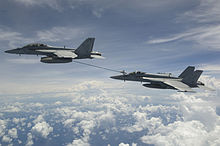
An F/A-18F refueling an F/A-18E over the Bay of Bengal, 2007
The Super Hornet, unlike the previous Hornet, is designed so it can be equipped with an aerial refueling system (ARS) or "buddy store" for the refueling of other aircraft,[38] filling the tactical airborne tanker role the Navy had lost with the retirement of the KA-6D and Lockheed S-3B Viking tankers. The ARS includes an external 330 US gallons (1,200 L) tank with hose reel on the centerline along with four external 480 US gallons (1,800 L) tanks and internal tanks for a total of 29,000 pounds (13,000 kg) of fuel on the aircraft.[38][39]
Airframe changes
The forward fuselage is unchanged, but the remainder of the aircraft shares little with earlier F/A-18C/D models. The fuselage was stretched by 34 inches (860 mm) to make room for fuel and future avionics upgrades and increased the wing area by 25%.[40] However, the Super Hornet has 42% fewer structural parts than the original Hornet design.[41] The General Electric F414 engine, developed from the Hornet's F404, has 35% additional thrust over most of the aircraft's flight envelope.[40][42] The Super Hornet can return to an aircraft carrier with a larger load of unspent fuel and munitions than the original Hornet. The term for this ability is known as "bringback". Bringback for the Super Hornet is in excess of 9,000 pounds (4,100 kg).[43]Other differences include approximately rectangular intakes for the engines and two extra wing hard points for payload (for a total of 11).[44] Among the most significant aerodynamic changes are the enlarged leading edge extensions (LEX) which provide improved vortex lifting characteristics in high angle of attack maneuvers, and reduce the static stability margin to enhance pitching characteristics. This results in pitch rates in excess of 40 degrees per second, and high resistance to departure from controlled flight.[45]
Radar signature reduction measures
Survivability is an important feature of the Super Hornet design. The U.S. Navy took a "balanced approach" to survivability in its design.[46] This means that it does not rely on low-observable technology, such as stealth systems, to the exclusion of other survivability factors. Instead, its design incorporates a combination of stealth, advanced electronic-warfare capabilities, reduced ballistic vulnerability, the use of standoff weapons, and innovative tactics that cumulatively and collectively enhance the safety of the fighter and crew.[47]
Two U.S. Navy F/A-18E Super Hornets fly a combat patrol over Afghanistan in 2008. The aircraft banking away in the background can be seen launching infra-red countermeasure flares.
The Super Hornet also makes considerable use of panel joint serration and edge alignment. Considerable attention has been paid to the removal or filling of unnecessary surface join gaps and resonant cavities. Where the F/A-18A-D used grilles to cover various accessory exhaust and inlet ducts, the F/A-18E/F uses perforated panels that appear opaque to radar waves at the frequencies used. Careful attention has been paid to the alignment of many panel boundaries and edges, to direct reflected waves away from the aircraft in uniformly narrow angles.[5]
It is claimed that the Super Hornet employs the most extensive radar cross section reduction measures of any contemporary fighter, other than the F-22 and F-35. While the F/A-18E/F is not a true stealth fighter like the F-22, it will have a frontal radar cross-section an order of magnitude smaller than prior generation fighters.[48]
Additional RCS reduction measures can be installed on an as needed basis.[49]
Avionics
Initially, the Super Hornet's avionics and software had a 90% commonality with that of the F/A-18C/D fleet at the time.[42] Differences include a touch-sensitive, up-front control display; a large liquid-crystal multipurpose color display; and a fuel display.[42] The Super Hornet has a quadruplex digital fly-by-wire system,[50] as well as a digital flight-control system that detects and corrects for battle damage.[45] Initial production models used the APG-73 radar, later replaced by the APG-79 Active Electronically Scanned Array (AESA).[16][17] The AN/ASQ-228 ATFLIR (Advanced Targeting Forward Looking InfraRed), is the main electro-optical sensor and laser designator pod for the Super Hornet. The communications equipment consist of an AN/ARC-210 VHF/UHF radio[51] and a MIDS low volume terminal for HAVE QUICK, SINCGARS and Link 16 connectivity.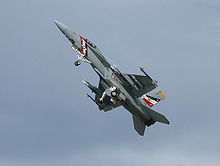
F/A-18F at Royal International Air Tattoo 2004
The Super Hornet Block II configuration includes the new APG-79 AESA radar; it enables its crew to execute simultaneous air-to-air and air-to-ground attacks. The APG-79 also provides higher quality high-resolution ground mapping at long standoff ranges.[53] The AESA radar can also detect smaller targets, such as inbound missiles[54] and can track air targets beyond the range of the Super Hornet's own air to air missiles.[55] VFA-213 became "safe for flight" (independently fly and maintain the F/A-18F) on 27 October 2006 and is the first Super Hornet squadron to fly AESA-equipped Super Hornets.[56]
The first Super Hornet upgraded with an aft cockpit Joint Helmet Mounted Cueing System (JHMCS) was delivered to VFA-213 on 18 May 2007.[57] The JHMCS provides multi-purpose aircrew situational awareness including high-off-bore-sight cuing of the AIM-9X Sidewinder missile. The Shared Reconnaissance Pod (SHARP) is a high-resolution, digital tactical air reconnaissance system that features advanced day/night and all-weather capability.[58] The Multifunctional Information Distribution System low volume communication terminal is being upgraded with the MIDS-JTRS system,[59] which will allow a tenfold increase in bandwidth as well as compatibility with the Joint Tactical Radio System standards. Initial operational capability is planned for January 2011.[60]
Variants
- F/A-18E Super Hornet: single seat variant.
- F/A-18F Super Hornet: two-seat variant.
- EA-18G Growler: The electronic warfare version of the F/A-18F Super Hornet. Went into low rate production in 2007, with fleet deployment in 2009. The EA-18G will replace the U.S. Navy's EA-6B Prowler.
Specifications (F/A-18E/F)
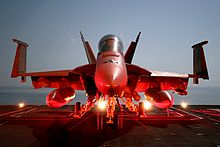
An F/A-18F parked on the flight deck of aircraft carrier USS Dwight D. Eisenhower, as the ship operates in the Arabian Sea, December 2006
- Crew: F/A-18E: 1, F/A-18F: 2
- Length: 60 ft 1¼ in (18.31 m)
- Wingspan: 44 ft 8½ in (13.62 m)
- Height: 16 ft (4.88 m)
- Wing area: 500 ft² (46.5 m²)
- Empty weight: 32,081 lb (14,552 kg)
- Loaded weight: 47,000 lb (21,320 kg) (in fighter configuration)
- Max. takeoff weight: 66,000 lb (29,937 kg)
- Powerplant: 2 × General Electric F414-GE-400 turbofans
- Dry thrust: 13,000 lbf (62.3 kN) each
- Thrust with afterburner: 22,000 lbf (97.9 kN) each
- Internal fuel capacity: F/A-18E: 14,400 lb (6,780 kg), F/A-18F: 13,550 lb (6,354 kg)
- External fuel capacity: 5 × 480 gal tanks, totaling 16,380 lb (7,381 kg)
- Maximum speed: Mach 1.8+[13] (1,370 mph, 1,915 km/h) at 40,000 ft (12,190 m)
- Range: 1,275 nmi (2,346 km) clean plus two AIM-9s[13]
- Combat radius: 390 nmi (449 mi, 722 km) for interdiction mission[118]
- Ferry range: 1,800 nmi (2,070 mi, 3,330 km)
- Service ceiling: 50,000+ ft (15,000+ m)
- Rate of climb: 44,882 ft/min[119] (228 m/s)
- Wing loading: 94.0 lb/ft² (459 kg/m²)
- Thrust/weight: 0.93
- Design load factor: 7.6 g[45]
- Guns: 1× 20 mm (0.787 in) M61 Vulcan nose mounted gatling gun, 578 rounds
- Hardpoints: 11 total: 2× wingtips, 6× under-wing, and 3× under-fuselage with a capacity of 17,750 lb (8,050 kg) external fuel and ordnance
- Missiles:
- Air-to-air missiles:
- 4× AIM-9 Sidewinder or 4× AIM-120 AMRAAM, and
- 2× AIM-7 Sparrow or additional 2× AIM-120 AMRAAM
- Air-to-surface missiles:
- Anti-ship missile:
- Air-to-air missiles:
- Bombs:
- B61 or B83 nuclear bomb
- JDAM precision-guided munition (PGMs)
- Paveway series of laser-guided bombs
- Mk 80 series of unguided iron bombs
- CBU-87 Combined Effects Munition
- CBU-78 Gator
- CBU-97
- Mk 20 Rockeye II
- Others:
- SUU-42A/A Flares/Infrared decoys dispenser pod and chaff pod or
- Electronic countermeasures (ECM) pod or
- AN/ASQ-228 ATFLIR Targeting pods or
- up to 3× 330 U.S. gallon (1,200 L) Sargent Fletcher drop tanks for ferry flight or extended range/loitering time or
- 1× 330 U.S. gal (1,200 L) tank and 4× 480 U.S. gal (1,800 L) tanks for aerial refueling system (ARS).
- Hughes APG-73 or Raytheon APG-79 Radar
- Northrop Grumman/ITT AN/ALE-165 self-protection jammer pod or BAE Systems AN/ALE-214 integrated defensive electronic countermeasures system
- Raytheon AN/ALE-50 or BAE Systems AN/ALE-55 towed decoy
- Northrop Grumman AN/ALR-67(V)3 radar warning receiver
- MIDS LVT or MIDS JTRS datalink transceive






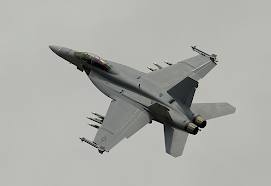
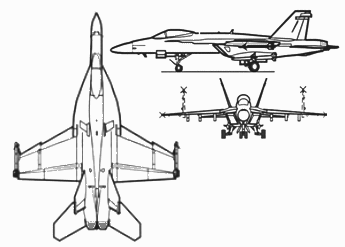
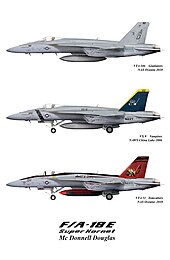

No comments:
Post a Comment